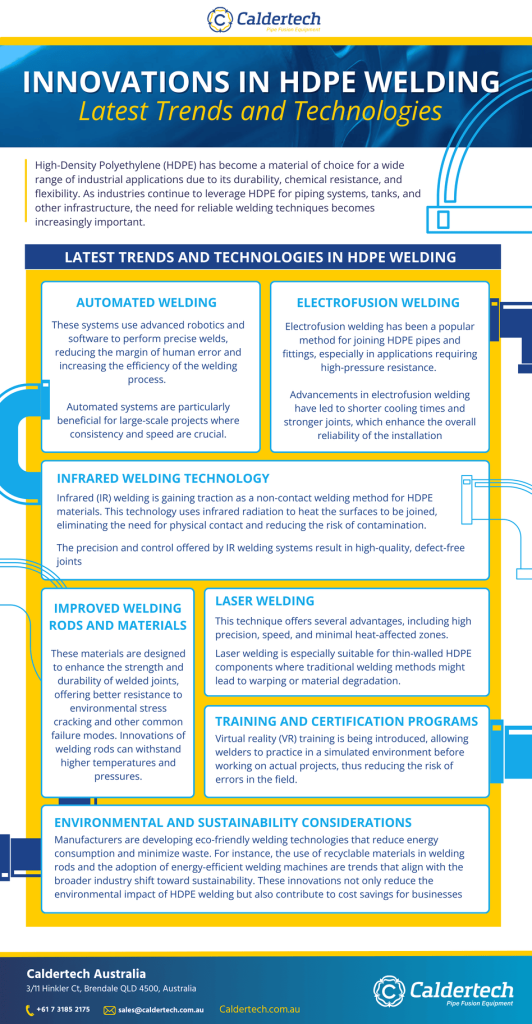High-Density Polyethylene (HDPE) has become a material of choice for a wide range of industrial applications due to its durability, chemical resistance, and flexibility. As industries continue to leverage HDPE for piping systems, tanks, and other infrastructure, the need for reliable welding techniques becomes increasingly important. Welding is a critical process in ensuring the integrity and longevity of HDPE installations. This article explores the latest trends and technologies in HDPE welding that are driving innovations in this field.
1. Automated Welding Systems
One of the most significant trends in HDPE welding is the rise of automated welding systems. These systems use advanced robotics and software to perform precise welds, reducing the margin of human error and increasing the efficiency of the welding process. Automated systems are particularly beneficial for large-scale projects where consistency and speed are crucial. They can handle complex welds with high repeatability, ensuring uniform quality across all welds.
2. Electrofusion Welding Advancements
Electrofusion welding has been a popular method for joining HDPE pipes and fittings, especially in applications requiring high-pressure resistance. Recent innovations in electrofusion technology include improvements in control systems and the development of smart fittings. These smart fittings can communicate with welding machines to provide real-time feedback on the welding process, ensuring optimal conditions are maintained throughout the weld. Additionally, advancements in electrofusion welding have led to shorter cooling times and stronger joints, which enhance the overall reliability of the installation.
3. Infrared Welding Technology
Infrared (IR) welding is gaining traction as a non-contact welding method for HDPE materials. This technology uses infrared radiation to heat the surfaces to be joined, eliminating the need for physical contact and reducing the risk of contamination. Infrared welding is particularly advantageous for applications that require sterile conditions or where traditional contact methods might cause damage to sensitive materials. The precision and control offered by IR welding systems result in high-quality, defect-free joints.
4. Laser Welding Techniques
Laser welding is an emerging technology in the HDPE welding landscape. This technique offers several advantages, including high precision, speed, and minimal heat-affected zones. Laser welding is especially suitable for thin-walled HDPE components where traditional welding methods might lead to warping or material degradation. As laser technology continues to evolve, we can expect to see more widespread adoption in HDPE welding, particularly in specialized applications where traditional methods fall short.
5. Improved Welding Rods and Materials
The development of new welding rods and materials tailored specifically for HDPE applications is another area of innovation. These materials are designed to enhance the strength and durability of welded joints, offering better resistance to environmental stress cracking and other common failure modes. Innovations in material science are also leading to the creation of welding rods that can withstand higher temperatures and pressures, expanding the range of applications for HDPE welding.
6. Enhanced Training and Certification Programs
With the increasing complexity of HDPE welding technologies, there is a growing emphasis on enhanced training and certification programs for welders. These programs are incorporating the latest advancements in welding technology, ensuring that welders are equipped with the skills needed to operate modern welding equipment and adhere to industry standards. Virtual reality (VR) training is also being introduced, allowing welders to practice in a simulated environment before working on actual projects, thus reducing the risk of errors in the field.
7. Environmental and Sustainability Considerations
Sustainability is becoming a key consideration in HDPE welding innovations. Manufacturers are developing eco-friendly welding technologies that reduce energy consumption and minimize waste. For instance, the use of recyclable materials in welding rods and the adoption of energy-efficient welding machines are trends that align with the broader industry shift toward sustainability. These innovations not only reduce the environmental impact of HDPE welding but also contribute to cost savings for businesses.
Conclusion
The HDPE welding industry is experiencing a wave of innovations driven by advancements in technology and a focus on sustainability. From automated welding systems and smart electrofusion fittings to laser and infrared welding techniques, these trends are shaping the future of HDPE installations. As these technologies continue to evolve, they promise to enhance the quality, efficiency, and reliability of HDPE welding, making it an even more viable option for a wide range of industrial applications. Keeping abreast of these trends will be crucial for businesses and professionals in the field to stay competitive and meet the growing demands of their clients.



